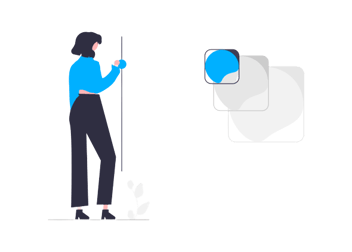Should customer support be part of customer success?
Both customer support teams and customer success teams strive to deliver an exceptional Customer Experience. However, while they are closely connected, customer support and customer success have a few distinctions that are important to know.
So let’s take a closer look at the definition of both roles and discover how they interrelate so that your teams can have the best chance of success.
What is customer support?
The purpose of customer support is to assist with and educate customers about products, particularly when there’s a problem with them. That includes giving instructions for using the product, troubleshooting issues, resolving queries, and guiding people to use product features.
Customer support teams are focused on the technical aspects of the product and are experts in what the product can do. In addition, they tend to work with other operational engineering and product teams, particularly to improve products and develop solutions that suit customers better.
Characteristics of customer support
- Focused on solutions, not the wider Customer Experience
- Reactive, solving problems as they arise
- Transactional and often direct
- Easier to measure return on investment (ROI)
What is customer success?
The role of customer success teams is to connect with customers and determine how the company can best meet their needs. From communicating with them to producing informative content for them to engage with, customer success teams are focused on improving the Customer Experience (CX) as a whole.
Unlike customer support, customer success pertains to the entire Customer Experience, not just the products. In prioritising this, your team can increase customer satisfaction and therefore boost customer retention.
Characteristics of customer success
- Proactive about improving the entire Customer Experience
- Relationship-oriented
- Difficult to measure the return on investment (ROI)
Balancing customer support and customer success
When working to improve the Customer Experience, you need to know how to balance practical reactive solutions with a personal proactive connection. If your approach is too methodical, your customers are likely to turn to another brand, knowing they’ll be treated more like valued customers.
That’s not to say you need to get rid of customer support teams, just that you need to equip your team members with tools and techniques to understand the customers better. Both customer support and customer success will help your business to grow, retain, and improve customer relationships, but only when they work collaboratively.
So when it comes to managing these two teams, customer support should be considered a crucial component of customer success. For a unified and holistic solution, both teams should work in harmony to ensure that customers are satisfied. Or, they should become one team able to manage both requirements.
Using customer data to improve the Customer Experience
To ensure everyone involved in customer support and success is on the same page, you need to make use of customer feedback data. Customer feedback gives insights into the experience your customers are having, allowing your teams to understand them better.
Your teams can use data to:
- Greet customers by name.
- Determine when to be reactive and when to be proactive.
- Understand the experience the customer is seeking.
- Identify common problems with products or services.
- Influence future product development.
While data is not enough on its own, it certainly gives your team a head start for optimising the Customer Experience. To tap into your customer insights, you simply need to ask.
Customer data and insights with Review Tui
To make use of your customer feedback, you need to implement a strategy and management system that turns raw data into actionable insights. To succeed, here are a few core pillars to focus on:
Measure customer satisfaction
When assessing how good your Customer Experience is, Customer Satisfaction (CSAT) is one of the most important metrics to track. Put simply, Customer Satisfaction surveys ask how happy a customer is with a particular aspect of their experience with the brand. These help to assess how well certain touchpoints in the buyer's journey are performing so you can make informed decisions toward improving them.
A common example of a CSAT question is:
‘How would you rate your experience with the product you received from us?’ (on a scale of 1-5)
On top of Customer Satisfaction, you could also look into other metrics like Customer Effort Scores (CES) or Net Promoter Scores (NPS). Each has its advantages so you could try combining them in a survey to get the best results.
Integrate with your Customer Relationship Management tool
When it comes to organising customer data, you can’t go past a Customer Relationship Management software like HubSpot. At Review Tui, all customer feedback data is seamlessly integrated with the HubSpot CRM, meaning you can sync everything into one cohesive place.
This integration gives you the ability to feed valuable contact information from your primary database into Review Tui. This way, surveys can be personalised and targeted to relevant customers rather than sent out manually or in a mass email.
Analyse customer data
Once you have customers' feedback, you must evaluate the responses to extract meaningful insights. This allows you to identify common trends and highlight areas in need of improvement. A Customer Feedback Management platform will do this for you, usually with automation. This way, you can see exactly what customers are saying without having to sift through endless raw data.
To help your customer support team, let them know what the most frequent product problems and challenges are. This enables them to work with product teams and make necessary changes sooner.
Communicate customer insights with your team
When you decide to collect and analyse customer feedback, it’s imperative that you feed the insights back to your customer-facing teams. This allows them to adjust their approach to customers according to real-world data and helpful suggestions.
We recommend implementing some form of regular communication with your teams so that they are as up-to-date as possible. This way, everyone can act with confidence, knowing they are providing the best service they can.
If your brand wants to better understand your customers and improve your service performance, Review Tui is right for you. With a user-friendly dashboard, powerful analytics, an easy-to-use survey builder, and traceable campaign links, it’s never been easier for teams to understand their clients.
Sign up to receive invite-only access to the software launch later this year, along with helpful advice on how to improve your feedback strategy.



